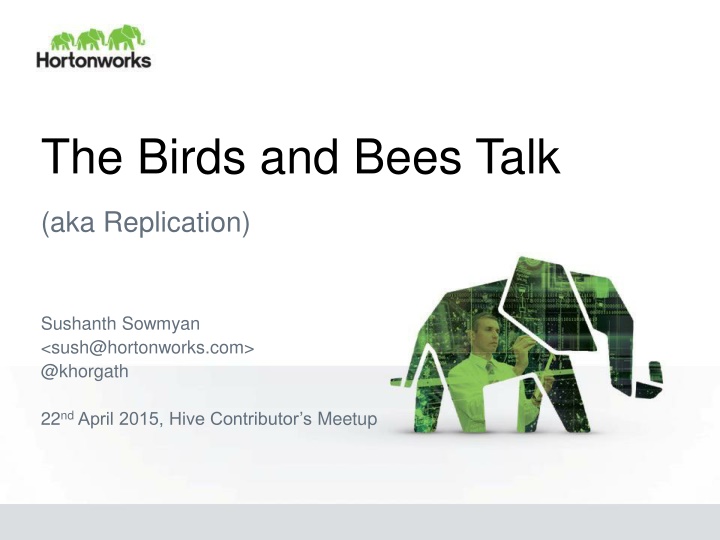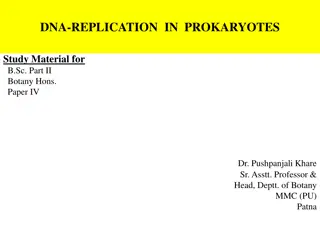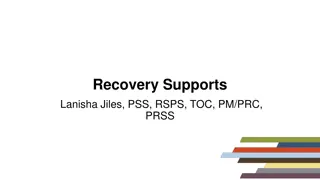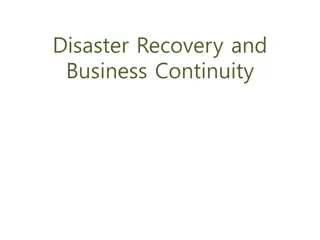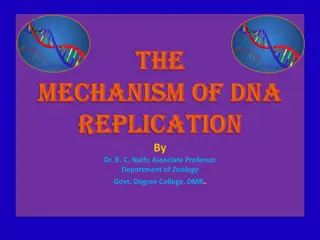Replication for Disaster Recovery - Simplifying Data Management
Concept of replication in data management for disaster recovery solutions. The discussion delves into utilizing tools like Falcon for enabling replication, the basic idea behind replication, considerations before implementation, taxonomy related to transaction handling, synchronization strategies, and the challenges posed by M-M models. Various aspects of load balancing and concurrency control are also highlighted.
Download Presentation

Please find below an Image/Link to download the presentation.
The content on the website is provided AS IS for your information and personal use only. It may not be sold, licensed, or shared on other websites without obtaining consent from the author.If you encounter any issues during the download, it is possible that the publisher has removed the file from their server.
You are allowed to download the files provided on this website for personal or commercial use, subject to the condition that they are used lawfully. All files are the property of their respective owners.
The content on the website is provided AS IS for your information and personal use only. It may not be sold, licensed, or shared on other websites without obtaining consent from the author.
E N D
Presentation Transcript
The Birds and Bees Talk (aka Replication) Sushanth Sowmyan <sush@hortonworks.com> @khorgath 22ndApril 2015, Hive Contributor s Meetup
Replication Need : Disaster recovery Solution : Replication, enabled through data management tools like Falcon Nice to have : Load balancing (but not our initial thrust / reason we do this.) Idea : We already have export & import, and we already have notifications, so it should be a simple matter to extend them to implement replication, right? Page 2
Replication : Basic Idea Every transaction that makes a change writes out a redo log item that contains the change that happened. This delta is replayed on all the replicas to make them a faithful copy of the original. We add replication capability to hive, but leave the actual execution to data management tools like Falcon. Page 3
Before we go on.. Approaches not considered: Feed-definition-based Other tools like Falcon already support this Complex config, more in data management scope HDFS+Metadata repl Multiple sources of truth headaches Partial replication issues Page 4
Taxonomy : Transaction source Transaction location : WHERE? primary copy write : M-S models simple concurrency control not great for non-read load-balancing because primary is still a chokepoint update anywhere : M-M models good load balancing solution complex concurrency control Page 5
Taxonomy : Synchronization Strategy Synchronization point : WHEN? eager strong consistency can have performance impact, longer response times lazy fast, optimizable can have stale data, temporary inconsistency Page 6
M-M models Great for load-balancing, but make concurrency control very difficult to achieve. "Good enough" if we achieve read-load- balancing for analytics loads. If need be, we can allow replication isolation T1 can replicate from A->B => T1 cannot be replicated from B->A, but does not prevent T2 being replicated from B->A We will ignore these for now until we solidify other aspects. Page 7
Synchronization Eager => Log is guaranteed written for every update that happens on the primary Lazy => Redo log is generated from the primary copy by a separate background daemon, done asynchronously Page 8
Eager Synchronization Log & Primary Copy Write approach Write the log & the primary copy before returning successfully from a transaction Costly in terms of disk & time Synchronous, so blocking Page 9
Eager Synchronization Write out an in-place edit log first, and return successfully when that gets written, manage compaction semantics and versioning semantics for readers (similar to what's implemented for ACID on hive) Good on performance, effectively asynchronous Increased complexity What happens if we return success to the user upon writing the delta, and then find that it fails on log-apply/compaction? Not compatible with our notion of external tables - dependent on external writer to perform operations in a required manner, rather than traditionally used approaches of simply writing in data into the directory and registering new data with hive. Page 10
Lazy Synchronization Redo Logs generated asynchronously, typically by background daemons/tools Lazy-Redo Concurrent copy Approach: Primary copy returns immediately, but needs to be able to provide snapshots or MVCC to make sure that this data does not change yet again during the time the redo log is being generated, keeps older copy around. Complex to implement What about DROP TABLE/etc ? External tables and external management make this more difficult. Page 11
Lazy Synchronization Robust-repeatable-replay of lazy logs(yes, I m going for alliteration here : help me out here by suggesting more things I can add) No guarantees that every single event translates to a delta => No need to keep versions at source. Captures latest version at source for every event Destination-apply needs to be robust and apply if the delta being applied is newer in state than the destination. Can be temporarily out-of-synch, but will keep rubber-banding to latest state. Bad for load balancing usecases Great for DR Stretches definition of eventual in eventual consistency. Page 12
Back to basics Event log for all operations on source warehouse {Create,Alter,Drop}{Database,Table,Partition} Export -> copy -> Import : Generify : Commands on source wh, copy if needed, Commands on dest wh Translate each event to a ReplicationTask (pluggable ReplicationTaskFactory allows third party implementation plugins) Third-party tool, like Falcon, consumes and executes ReplicationTasks. Page 13
Brass Tacks Creates => Export/Import if import is newer than dest object Alters => Export metadata/Import metadata if import is newer than dest object Drop = > Drop if event that spawned the drop is newer than dest object. Page 14
DDL Additions EXPORT [FOR [METADATA] REPLICATION( )] DROP TABLE [FOR REPLICATION( eventid )] ALTER TABLE DROP PARTITION [FOR REPLICATION( eventid )] Page 15
Future Work Planned: Event nullification/collapsing Views, Functions, Roles replication ACID interop HDFS based eventlog rather than metastore-based one. Maybe?: Single EXPORT/IMPORT command for database level Export-to-queue & Import-from-queue semantics & kafka interop? Other repl implementations like Hive->MySQL/Oracle/? & MySQL/Oracle/?->Hive Page 16
References Umbrella jira : HIVE-7973 Documentation tracking : HIVE-10246 https://cwiki.apache.org/confluence/display/Hive/HiveReplicationD evelopment (work-in-progress) Kemme, Bettina, Ricardo Jim nez-Peris , Marta Pati o-Mart nez, and Gustavo Alonso. "12.2 Basic Taxonomy for Replica Control Approaches." Replication Theory and Practice. By Bernadette Charron-Bost, Fernando Pedone, and Andr Schiper. Berlin: Springer-Verlag, 2010. N. pag. Print. Page 17
